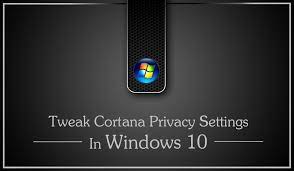Navigating Privacy: A Comprehensive Guide to Tweak Cortana Privacy Settings in Windows 10

Introduction
Cortana, Microsoft’s virtual assistant, has evolved to become an integral part of the Windows 10 operating system, offering users a range of features to enhance productivity and streamline daily tasks. However, as technology advances, so does the importance of privacy. In this extensive guide, we will explore the intricacies of Cortana’s privacy settings in Windows 10, shed light on the significance of privacy customization, and provide a detailed, step-by-step walkthrough on tweaking Cortana’s privacy settings to align with individual preferences.
Understanding Cortana’s Role and Privacy Concerns
Cortana is designed to assist users by providing personalized recommendations, reminders, and information based on their preferences and usage patterns. While these features can undoubtedly enhance the user experience, privacy concerns have become a focal point in the digital age. Users often seek the ability to customize Cortana’s privacy settings to strike a balance between enjoying the benefits of the virtual assistant and safeguarding their personal information.
The Significance of Customizing Cortana Privacy Settings
Customizing Cortana’s privacy settings allows users to tailor their experience, control the data shared with Microsoft, and mitigate privacy-related concerns. By understanding and adjusting these settings, users can strike a balance between enjoying the convenience of Cortana and maintaining a level of privacy that aligns with their comfort level.
Advantages of Tweaking Cortana Privacy Settings
- Enhanced Control: Customizing Cortana’s privacy settings provides users with enhanced control over the information shared with the virtual assistant. This control is crucial for individuals who are mindful of their digital footprint and seek to limit data exposure.
- Tailored Experience: Adjusting privacy settings allows users to tailor Cortana’s responses and recommendations to their preferences. This customization ensures a more personalized and relevant experience without compromising on privacy.
- Data Transparency: Cortana privacy settings offer transparency into the type of data collected and how it is used. Users can make informed decisions about the information they are comfortable sharing, fostering a sense of trust in the digital ecosystem.
- Reduced Annoyance: Tweaking privacy settings allows users to manage the frequency and nature of Cortana’s interactions. This reduces the potential for unwanted interruptions or suggestions, creating a more seamless and user-friendly experience.
Step-by-Step Guide: Tweaking Cortana Privacy Settings in Windows 10
Now, let’s explore the step-by-step process of tweaking Cortana’s privacy settings in Windows 10:
Step 1: Open Cortana Settings
Click on the Cortana icon on your taskbar or press the Windows key and type “Cortana” to open the settings menu. Select “Settings” from the available options.
Step 2: Navigate to Privacy Settings
Within the Cortana settings, locate and click on “Privacy.” This section provides access to various privacy-related configurations.
Step 3: Adjust Permissions
Review the permissions settings to control Cortana’s access to your data. Toggle switches to enable or disable permissions related to location, contacts, voice input, and more, depending on your preferences.
Step 4: Manage Cloud Content
Explore the “Cloud Content” section to manage the information Cortana collects from your device and Microsoft account. Adjust settings related to search history, notebook data, and other cloud content to align with your privacy preferences.
Step 5: Review Inking and Typing Data
In the “Inking & typing” section, manage the collection of typing and inking data to enhance Cortana’s performance. Adjust settings based on your comfort level with sharing this type of information.
Step 6: Control Cortana’s Communication with Microsoft
Navigate to the “Speech, inking & typing” section to control how Cortana interacts with Microsoft servers. Adjust settings related to speech recognition, typing suggestions, and inking recognition to customize your experience.
Step 7: Adjust Diagnostic Data Settings
Explore the “Diagnostics & feedback” section to control the amount of diagnostic data sent to Microsoft. Choose between basic and full diagnostic data options based on your preferences for data sharing.
Step 8: Manage Advertising ID
In the “Other privacy settings” section, review and manage your advertising ID settings. Adjusting these settings can impact the personalized advertisements you encounter while using Cortana and other Microsoft services.
Step 9: Explore App Permissions
Review and manage individual app permissions within the “Permissions” section. Customize which apps have access to Cortana-related data to enhance control over your privacy.
Step 10: Stay Informed
Regularly revisit Cortana privacy settings to stay informed about updates and changes. Microsoft periodically updates its features, and being aware of privacy-related adjustments ensures ongoing control over your digital privacy.
Conclusion
Tweaking Cortana privacy settings in Windows 10 is a crucial step in harnessing the full potential of the virtual assistant while maintaining control over personal information. By following the comprehensive step-by-step guide provided in this overview, users can navigate Cortana’s privacy settings with confidence, customizing their experience to align with individual preferences. As technology continues to advance, the power to manage privacy settings empowers users to strike a balance between convenience and data protection within the Windows 10 ecosystem. Embrace the transparency and control offered by Cortana privacy settings, and enjoy a personalized and secure digital experience tailored to your comfort level.







